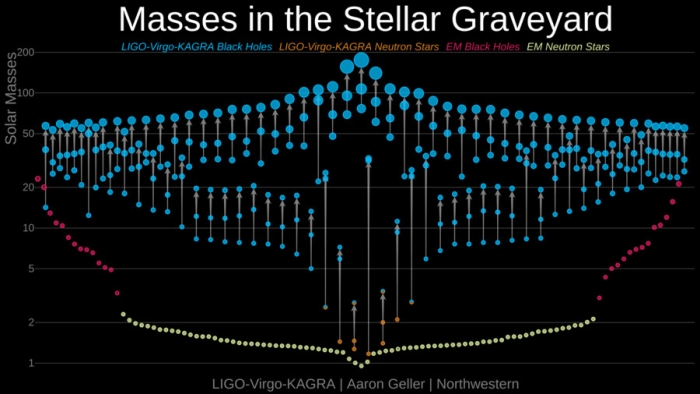The most recent gravitational wave observing run has netted the biggest haul yet.
In less than five months, from November 2019 to March 2020, the LIGO-Virgo interferometers recorded a massive 35 gravitational wave events. On average, that's almost 1.7 gravitational wave events every week for the duration of the run.
This represents a significant increase from the 1.5-event weekly average detected on the previous run, and a result that has plumped up the number of total events to 90 since that first history-making gravitational wave detection in September 2015.
"These discoveries represent a tenfold increase in the number of gravitational waves detected by LIGO and Virgo since they started observing," said astrophysicist Susan Scott of the Australian National University in Australia.
"We've detected 35 events. That's massive! In contrast, we made three detections in our first observing run, which lasted four months in 2015-16. This really is a new era for gravitational wave detections and the growing population of discoveries is revealing so much information about the life and death of stars throughout the Universe."
Of the 35 new detections, 32 are most likely the result of mergers between pairs of black holes. This is when pairs of black holes on a close orbit are drawn in by mutual gravity, eventually colliding to form one single, more massive black hole.
That collision sends ripples through space-time, like the ripples generated when you throw a rock in a pond; astronomers can analyze those ripples to determine the properties of the black holes.

The data revealed a range of black hole masses, with the most massive clocking in at around 87 times the mass of the Sun. That black hole merged with a companion 61 times the mass of the Sun, resulting in a single black hole 141 times the mass of the Sun. That event is named GW200220_061928.
Another merger produced a black hole 104 times the mass of the Sun; both of these are considered intermediate mass black holes, a mass range between 100 and around a million solar masses, in which very few black holes have been detected.
GW200220_061928 is also interesting, because at least one of the black holes involved in the merger falls into what we call the upper mass gap. According to our models, black holes over about 65 solar masses can't form from a single star, as stellar mass black holes do.
That's because the precursor stars are so massive that their supernovae - known as pair-instability supernovae - ought to completely obliterate the stellar core, leaving nothing behind to gravitationally collapse into a black hole.
This suggests that the 87 solar mass black hole might be the product of a previous merger. GW200220_061928 isn't the first that's involved a black hole in the upper mass gap, but its detection does suggest that hierarchical black hole mergers are not uncommon.
And another event includes an object in the lower mass gap – a gap of black holes between 2.5 and 5 times the mass of the Sun. We've not conclusively found a neutron star larger than the former, or a black hole smaller than the latter; the event named GW200210_092254 involved an object clocking in at 2.8 solar masses. Astronomers have concluded that it's probably a very small black hole.
"Looking at the masses and spins of the black holes in these binary systems indicates how these systems got together in the first place," Scott said.
"It also raises some really fascinating questions. For example, did the system originally form with two stars that went through their life cycles together and eventually became black holes? Or were the two black holes thrust together in a very dense dynamical environment such as at the centre of a galaxy?"
The other three events out of the 35 involved a black hole and something else much less massive, likely a neutron star. These events are of great interest to astronomers, since they might reveal the stuff that's inside a neutron star - if we ever detect one that emits light. By finding more of these mergers, we can start to build a better understanding of how they actually occur.
"Only now are we starting to appreciate the wonderful diversity of black holes and neutron stars," said astronomer Christopher Berry of the University of Glasgow in the UK
"Our latest results prove that they come in many sizes and combinations – we have solved some long-standing mysteries, but uncovered some new puzzles too. Using these observations, we are closer to unlocking the mysteries of how stars, the building blocks of our Universe, evolve."
The team's paper has been submitted for publication, and can be found on preprint server arXiv.



No comments:
Post a Comment